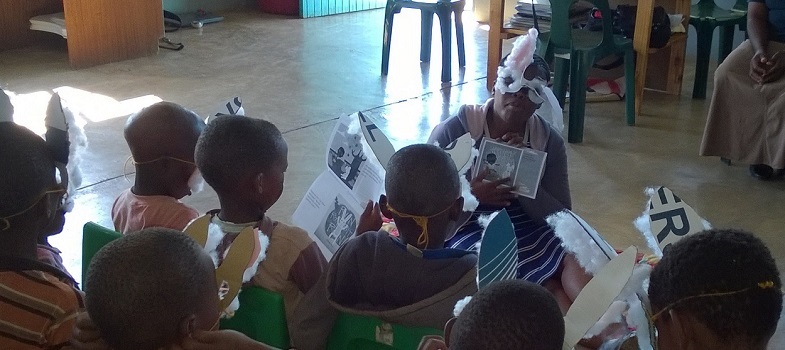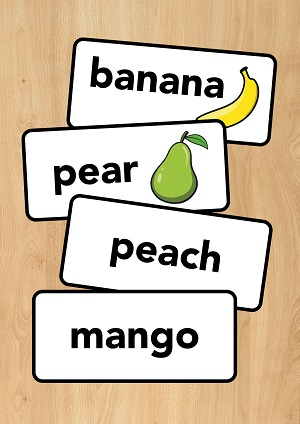Method 2: Look-and-say
The look-and-say method of teaching reading links whole words with their meanings without breaking them down into sounds first.
The meaning of the word and how it can be used in different contexts is very important. Children need to remember the shape and look of the word so that they recognise it when they see it again – in other words, it relies on a child’s visual memory.
If the teacher only uses this method, the child may become lost if they do not recognise the words. Because of this, effective teachers combine the phonics method and the look-and say method when teaching reading.
The look-and-say method is very useful for the many words whose spellings do not match their sounds, such as ‘the’, ‘said’ or ‘when’ in English. When you are teaching a language that has a more regular sound-symbol correspondence, it is easier to match letters to sounds. Sounds and letters in most African languages are linked in a more regular way, which makes it easier for children to learn to read using phonics.
Read Case Study 4.2 and answer the questions that follow in Activity 4.2.
Case Study 4.2: Mrs Mapuru uses the look-and-say method
Mrs Mapuru is teaching Grade 2 in a school situated in a rural area. Her children have had more than a year learning to read in their mother tongue and are now learning English and building reading skills in English.
She has collected pictures of fruits and pasted them on to cards. Each card has the English name of the fruit under the picture. She has also made about 15 sets of four cards, each of which has only the name of a fruit with no picture.
She holds the picture cards up one by one and makes sure that the children know the names of the different fruits: banana, apple, pear, peach, mango, etc. She then shuffles the cards and holds them up in a different order, letting the children chorus the names of the fruits. She repeats the name and spells out the words: ‘Mango, m–a–n–g–o, mango.’ She does this a few times, encouraging the class to say it with her.
Mrs Mapuru then uses a set of cards without pictures and lets children put up their hands and try to read the words. She does not break down the names of the fruits into sounds; children have to read words as a whole. She goes back to the picture words once or twice and then tries the cards without pictures again. Then she sticks the cards with pictures and words on her English word wall.
She divides the class into pairs. Each pair has a set of four cards. They try to read them, turning them over one by one and reading them to each other. They try to read them without looking at the word wall first, but if they are stuck they can get help by looking at the wall. Pairs can exchange their sets of cards with another pair once they can read them well without looking at the word wall.
After this, Mrs Mapuru can ask the children about different kinds of fruits: ‘What other kinds of fruits do you know?’, ‘What colour is a banana?’, ‘How do you eat a banana, do you eat it with the cover on or do you need to peel it?’, and so on. She can let them talk in pairs about the fruits that they know and the ones they like the best. Then they can report back to the class about their favourite fruits, using a sentence she gives them: ‘I like to eat (bananas).’ As they say their sentence, they hold up the word.
Later, she reads a story about fruit to the children and builds a lesson around it. You can read about that in Section 5.
This case study is also available to download. [Tip: hold Ctrl and click a link to open it in a new tab. (Hide tip)]
Activity 4.2: Thinking about ‘look-and-say’
Having read Case Study 4.2, talk to a colleague or a friend about the following questions. If you have no partner, write your ideas in your study notebook.
- How is the teacher using the look-and-say method?
- How does Mrs Mapuru use this method to help the children to read words describing fruit?
- How does she make sure that each child is actively involved in the lesson?
- How does she make sure that the children understand the meaning of the words they read?
- How do you think Mrs Mapuru made her picture cards? Where could she have found pictures to cut out? Could she or her children have drawn the pictures of fruit? Can you think of other ways she could have collected the pictures?
- Where could Mrs Mapuru have found cardboard to stick the pictures onto? Are there boxes in your area that you can collect and cut up for flash cards and charts?
- What other kinds of objects could you use to teach a lesson similar to Mrs Mapuru’s?
In English, there are many small but very common and important words, such as ‘the’, ‘of’, ‘for’, ‘to’, ‘said’, ‘when’, ‘is’, ‘are’, ‘was’ and ‘were’.
Which of these words can easily be sounded out? You will see that only a few of them can. It is also impossible to draw pictures of these words. Most of these are therefore best learned in the context of a poem or a story as part of a look-and-say approach. You need to teach them to your children using the look-and-say method and have them written in a special place on your word wall. This will help the children to ‘write’ them in their visual memories, where they won’t be forgotten.
Activity 4.3: Look-and-say words
Think of ‘look-and-say’ words in English that would be suitable for your word wall. Make a chart for your word wall if your children are learning English.
Think about the children’s home language. Does it have common words that are difficult to sound out, which children need to know by sight? Make a list of them on a chart for your word wall.
Optional activity: You could help the children you teach by becoming familiar with the letters that make up words, asking them to look for words within a word. How many words can you make from ‘mango’, for example? Can you think of some word in English or in your home language that you could use?
Three different methods




